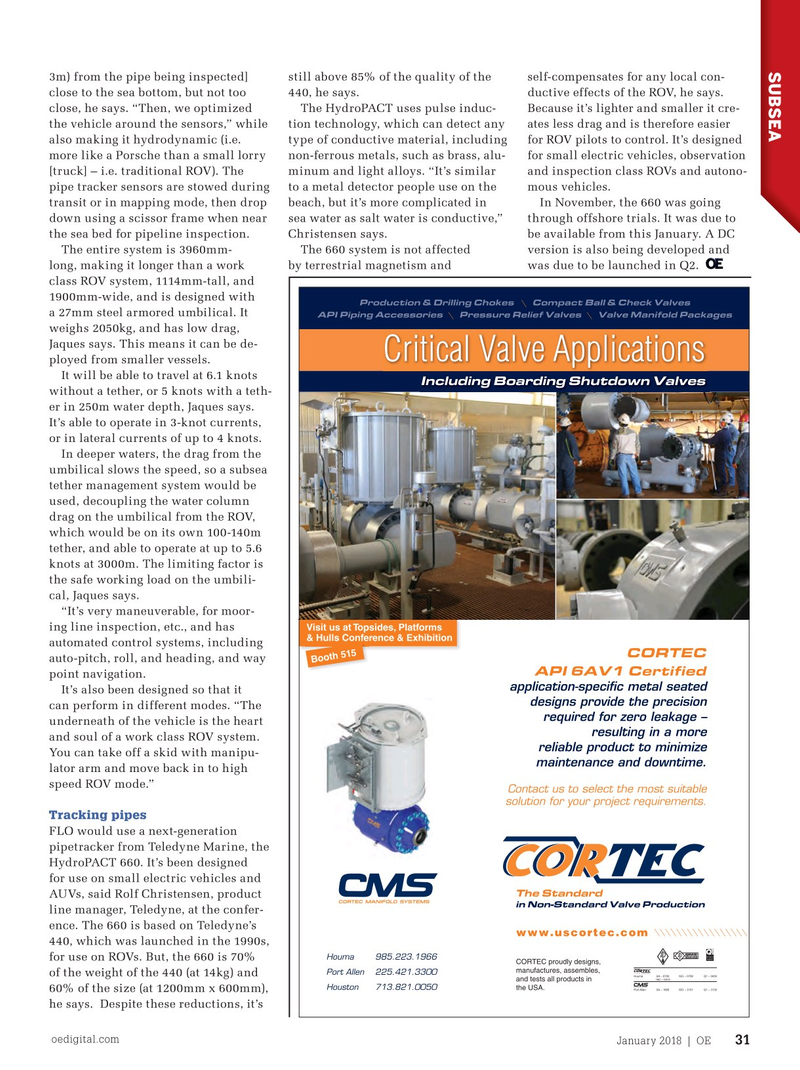
Page 29: of Offshore Engineer Magazine (Jan/Feb 2018)
Read this page in Pdf, Flash or Html5 edition of Jan/Feb 2018 Offshore Engineer Magazine
SUBSEA 3m) from the pipe being inspected] still above 85% of the quality of the self-compensates for any local con- close to the sea bottom, but not too 440, he says. ductive effects of the ROV, he says. close, he says. “Then, we optimized The HydroPACT uses pulse induc-
Because it’s lighter and smaller it cre- the vehicle around the sensors,” while tion technology, which can detect any ates less drag and is therefore easier also making it hydrodynamic (i.e. type of conductive material, including for ROV pilots to control. It’s designed more like a Porsche than a small lorry non-ferrous metals, such as brass, alu- for small electric vehicles, observation [truck] – i.e. traditional ROV). The minum and light alloys. “It’s similar and inspection class ROVs and autono- pipe tracker sensors are stowed during to a metal detector people use on the mous vehicles. transit or in mapping mode, then drop beach, but it’s more complicated in In November, the 660 was going down using a scissor frame when near sea water as salt water is conductive,” through offshore trials. It was due to the sea bed for pipeline inspection. Christensen says. be available from this January. A DC
The 660 system is not affected
The entire system is 3960mm- version is also being developed and by terrestrial magnetism and long, making it longer than a work was due to be launched in Q2. class ROV system, 1114mm-tall, and 1900mm-wide, and is designed with
Production & Drilling Chokes Compact Ball & Check Valves \ a 27mm steel armored umbilical. It
API Piping Accessories Pressure Relief Valves Valve Manifold Packages \ \ weighs 2050kg, and has low drag,
Jaques says. This means it can be de-
Critical Valve Applications ployed from smaller vessels.
It will be able to travel at 6.1 knots Including Boarding Shutdown Valves without a tether, or 5 knots with a teth- er in 250m water depth, Jaques says.
It’s able to operate in 3-knot currents, or in lateral currents of up to 4 knots.
In deeper waters, the drag from the umbilical slows the speed, so a subsea tether management system would be used, decoupling the water column drag on the umbilical from the ROV, which would be on its own 100-140m tether, and able to operate at up to 5.6 knots at 3000m. The limiting factor is the safe working load on the umbili- cal, Jaques says. “It’s very maneuverable, for moor- ing line inspection, etc., and has
Visit us at Topsides, Platforms & Hulls Conference & Exhibition automated control systems, including
CORTEC auto-pitch, roll, and heading, and way
Booth 515
API 6AV1 Certified point navigation. application-specific metal seated
It’s also been designed so that it designs provide the precision can perform in different modes. “The required for zero leakage – underneath of the vehicle is the heart resulting in a more and soul of a work class ROV system. reliable product to minimize
You can take off a skid with manipu- maintenance and downtime.
lator arm and move back in to high speed ROV mode.”
Contact us to select the most suitable solution for your project requirements.
Tracking pipes
FLO would use a next-generation pipetracker from Teledyne Marine, the
HydroPACT 660. It’s been designed for use on small electric vehicles and
The Standard
AUVs, said Rolf Christensen, product in Non-Standard Valve Production line manager, Teledyne, at the confer- ence. The 660 is based on Teledyne’s \\\\\\\\\\\\\\\\\ www.uscortec.com 440, which was launched in the 1990s,
Houma 985.223.1966 for use on ROVs. But, the 660 is 70%
CORTEC proudly designs, manufactures, assembles,
Port Allen 225.421.3300 of the weight of the 440 (at 14kg) and
Houma 6A – 0700 ISO – 0708 Q1 – 0450 16C – 0314 and tests all products in
Houston 713.821.0050 the USA.
Port Allen 6A – 1866 ISO – 3101 Q1 – 3130 60% of the size (at 1200mm x 600mm), he says. Despite these reductions, it’s oedigital.com
January 2018 | OE 31
Cortec OffshoreEngAd_Jan2018.indd 1 12/22/17 10:10 AM 028_OE0118_Subsea1_AUV-ROV.indd 31 12/27/17 6:57 PM

 28
28

 30
30